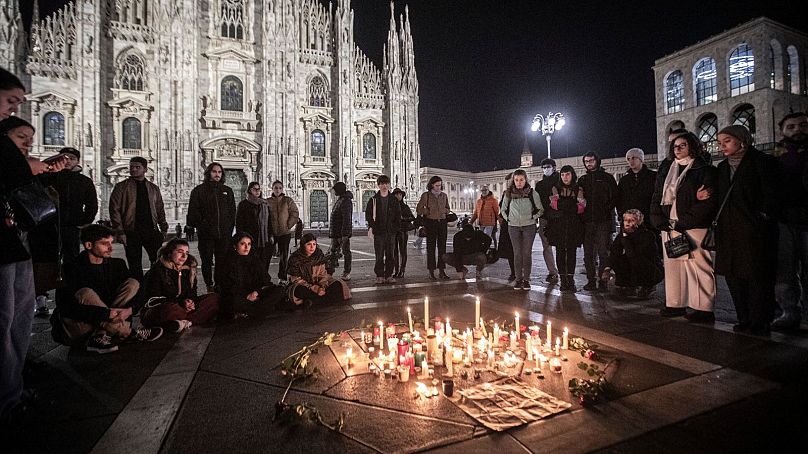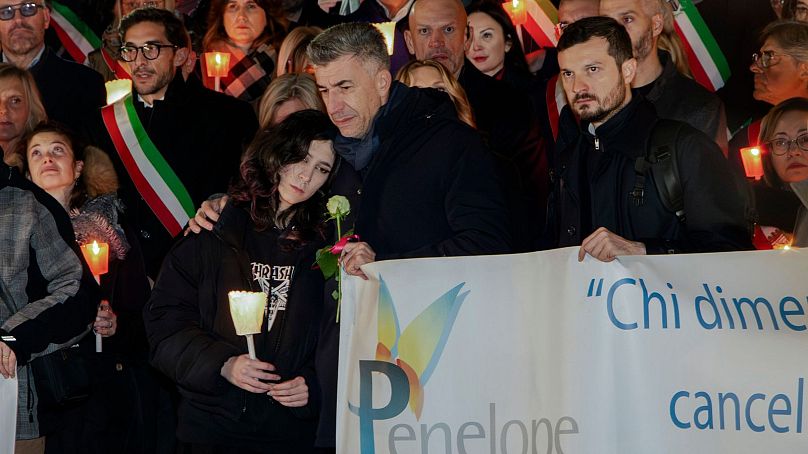The country has increased funding to anti-violence centres and women's shelters - but not enough is being done in terms of prevention, activists and experts told Euronews.
After the brutal murder of Giulia Cecchettin, a 22-year-old engineering student who’s believed to have been killed by her ex-boyfriend last week, Italy is once again being confronted with the rising problem of gender violence.
According to data from Italy’s Interior Ministry, Cecchettin is the 102th femicide victim in the country since the beginning of the year. Some 52 of these women were killed by a partner or former partner.
A wave of anger and sadness followed Cecchettin’s death, which was confirmed on Saturday when her body was found with at least 20 stab wounds a week after she disappeared with her ex-boyfriend Filippo Turetta, also 22. Turetta, who was arrested a day later in Germany, has been charged with murder, though investigations are still ongoing.
Italy’s Prime Minister Giorgia Meloni joined the many public officials and members of the public who have expressed sorrow and anger for the young woman’s death, promising a new educational campaign in schools to eradicate the toxic culture of violence existing in the country.
She also noted that her government has increased the funds dedicated to anti-violence centres and women’s refuges across the country, and is aiming to pass new, stricter regulations against those who commit violence and abuses against women and girls.
But talking to Euronews, Antonella Veltri, the president of Italy’s most important network coordinating anti-violence centres across the country, Donne in Rete Contro la Violenza or Di.Re, said that women’s refuges have not yet seen these new, increased funds.
Bureaucracy getting in the way
“We have absolutely no knowledge of this increase in funding that Premier Meloni has announced,” Veltri said. “In Italy, anti-violence centres benefit from structural funds that should grant our very same existence,” she continued. “But the last checks we got were for 2022, and those were issued by Italy’s regional authorities in part throughout this year. The funds for 2023 haven’t been issued yet, and we have no idea when, and if, they will be,” she added.
“In reality, there hasn’t been an increase in funding because we haven’t gotten this €40 million yet,” Veltri said, adding that the reason for this delay has to do with the stuffy Italian bureaucracy.
Di.Re manages 107 anti-violence centres across 19 Italian regions and they help as many as 20,000 women every year, according to Veltri. “This number has remained more or less unchanged through the years, which is proof that violence against women is a structural problem which has deep roots in our country and the government’s policies to fight it aren’t working.”
Anti-violence centres are vital in helping women facing gender violence, giving them the possibility to relocate to 62 women’s refuges across the country.
A lack of prevention
Despite a renewed focus on the problem of femicide - which is not recognised as a standalone crime in Italian law - and more funds officially issued to women’s organisations, the number of women killed by family members, former or current partners has increased in the past year.
Why? Veltri thinks that “nothing is being done in terms of prevention.” That is, Italy is throwing money at the problem - though this money hasn’t yet been received by groups like Di.Re - but not trying to eradicate the root of the problem, Italy’s long-held chauvinist traditions.
The numbers back up Veltri’s statement. As reported by NGO Action Aid in the study called “Discounted prevention” (“Prevenzione sottocosto”), the resources dedicated to fighting violence against women in Italy have increased by 156% in the past 10 years - but the numbers of femicides have remained the same. In 2014, there were 119 femicides in Italy. In 2022, there were 104.
The majority of the new resources issued between 2013 and 2023, 81% or €200 million, was dedicated to financing projects aimed at protecting women from the immediate risk violence, while only 12% was issued for prevention projects and 7% for long-term actions tackling the wider system of oppression and discrimination against women.
According to Action Aid, the government’s action is focused on helping victims after the violence has already occurred - meaning its intervention is always too late, failing to tackle the toxic, misogynistic culture at the heart of the problem.
In the past three years, Italy has spent only €30.9 million in projects aiming to prevent violence against women, with a drop of 70% in funding for prevention between 2022 and 2023.
“A medium- and long-term strategy which would address the patriarchal and chauvinist culture of the country harming girls and women is more or less absent,” the Action Aid’s report reads. “This cultural change, which was hailed by the past and current governments, can’t be done at no cost for the state.”
‘Harsher sentences not the solution’
Prevention is what would be needed to try to fix the problem of femicide in Italy, Alessandra Viviani, associate professor of international law at the University of Siena, told Euronews.
“Now we’re talking about harsher sentences for those who commit violence against women, and this is not the solution,” she said. “I don’t think that this latest femicide [Giulia Cecchettin’s murder] has changed the way this phenomenon is represented in the media or talked about by politicians.”
When Cecchettin’s sister, Elena Cecchettin, talked to the media about Filippo Turetta being “not a monster, but the healthy son” of Italy’s patriarchal culture, she was attacked by the media and some politicians as being too “politicised.”
Admitting that there’s a problem within the country’s culture and society “is a polarising issue” in Italy, where the word “gender” is loaded with controversy, Viviani said.
While femicide can be linked to an individual with his own personal problems, Viviani said that the solution is to recognise the crime of femicide and its cultural roots and address inequality and discrimination in Italian society.
The other victims. What happens to those left behind?
Many of the women killed in Italy since 2014 were mothers who were forced to leave behind their children.
According to data from EURES, there are about 2,000 children and youth who lost their mothers to femicide in Italy between 2009 and 2021. In 80% of the cases, it was their father who killed their mothers - meaning those young people lost both their parents in one single, traumatic event.
A recent report by the organisation Con i Bambini (With the Children) which analysed the fate of 157 children made orphans by femicide and found that 42% of these kids now live with a foster family.
Most often, the children are taken in by social services or close relatives - grandparents, uncles and aunts - though this doesn’t count as a formal adoption, and the status of the children remains unclear. Only 5% of the children of femicide victims are adopted and live with their adoptive families.
By law, families who take in children of femicide victims should receive €300 a month, but not many know about the existence of this option, which is not often implemented, as writes Internazionale.
One in three borne witness to the crime - something which could have life-changing consequences on the children, causing them deep trauma.













